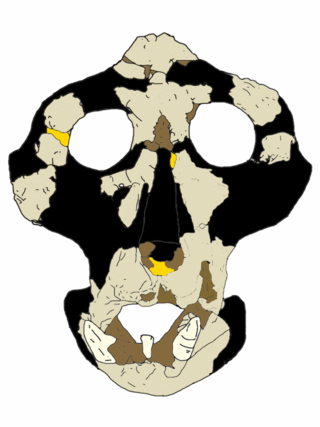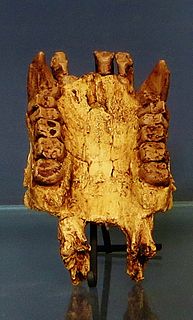
Mary Douglas Leakey, FBA was a British paleoanthropologist who discovered the first fossilised Proconsul skull, an extinct ape which is now believed to be ancestral to humans. She also discovered the robust Zinjanthropus skull at Olduvai Gorge in Tanzania, eastern Africa. For much of her career she worked with her husband, Louis Leakey, at Olduvai Gorge, where they uncovered fossils of ancient hominines and the earliest hominins, as well as the stone tools produced by the latter group. Mary Leakey developed a system for classifying the stone tools found at Olduvai. She discovered the Laetoli footprints, and at the Laetoli site she discovered hominin fossils that were more than 3.75 million years old.

Proconsul is an extinct genus of primates that existed from 21 to 14 million years ago during the Miocene epoch. Fossil remains are present in Eastern Africa including Kenya and Uganda. Four species have been classified to date: P. africanus, P. gitongai, P. major and P. meswae. The four species differ mainly in body size. Environmental reconstructions for the Early Miocene Proconsul sites are still tentative and range from forested environments to more open, arid grasslands.

Dryopithecus is a genus of extinct great apes from the middle–late Miocene boundary of Europe 12.5 to 11.1 million years ago (mya). Since its discovery in 1856, the genus has been subject to taxonomic turmoil, with numerous new species being described from single remains based on minute differences amongst each other, and the fragmentary nature of the holotype specimen makes differentiating remains difficult. There is currently only one uncontested species, the type species D. fontani, though there may be more. The genus is placed into the tribe Dryopithecini, which is either an offshoot of orangutans, African apes, or is its own separate branch.

Proconsul africanus was an ape which lived from about 23 to 14 million years ago during the Miocene epoch. It was a fruit eater and its brain was larger than that of a monkey, although probably not as large as that of a modern ape.

Afropithecus is a genus of Miocene hominoid with the sole species Afropithecus turkanensis, it was excavated from a small site near Lake Turkana called Kalodirr in northern Kenya in 1986 and named by Richard Leakey and Meave Leakey. The estimated age of Afropithecus is between 16 and 18 million years old, which was determined with radiometric dating techniques and the geological studies conducted by Broschetto and Brown from the University of Utah. In total there are 46 recovered specimens from Kalodirr relating to Afropithecus consisting of cranial, mandible, dentition and post-cranial remains. The type specimen of Afropithecus turkanensis is KNM-WK 16999.

Kenyapithecus wickeri is a fossil ape discovered by Louis Leakey in 1961 at a site called Fort Ternan in Kenya. The upper jaw and teeth were dated to 14 million years ago. One theory states that Kenyapithecus may be the common ancestor of all the great apes. More recent investigations suggest Kenyapithecus is more primitive than that and is only slightly more modern than Proconsul, which is considered to be an ape.

Ouranopithecus is a genus of extinct Eurasian great ape represented by two species, Ouranopithecus macedoniensis, a late Miocene hominoid from Greece and Ouranopithecus turkae, also from the late Miocene of Turkey.

Rusinga Island, with an elongated shape approximately 10 miles (16 km) from end to end and 3 miles (5 km) at its widest point, lies in the eastern part of Lake Victoria at the mouth of the Winam Gulf. Part of Kenya, it is linked to Mbita Point on the mainland by a causeway.

Proconsulidae is an early family of primates that lived during the Miocene epoch in Kenya, and was restricted to Africa. Members of the family have a mixture of Old World monkey and ape characteristics, so the placement in the ape superfamily Hominoidea is tentative; some scientists place Proconsulidae outside of Hominoidea in a separately superfamily Proconsuloidea, before the split of the apes and Old World monkeys.
David Pilbeam is the Henry Ford II Professor of the Social Sciences at Harvard University and curator of paleoanthropology at the Peabody Museum of Archaeology and Ethnology. He is a member of the National Academy of Sciences. He received his Ph.D. from Yale University.

Anoiapithecus is an extinct ape genus thought to be closely related to Dryopithecus. Both genera lived during the Miocene, approximately 12 million years ago. Fossil specimens named by Salvador Moyà-Solà are known from the deposits from Spain.
Kamoyapithecus was a primate that lived in Africa during the late Oligocene period, about 24.2-27.5 million years ago. First found in 1948 as part of a University of California, Berkeley expedition, it was at first thought to be under a form of Proconsul by C.T. Madden in 1980, but after a re-examination by Meave Leakey and associates later, the fossils were moved under a new genus Kamoyapithecus, named after the renowned fossil finder Kamoya Kimeu. The genus is represented by only one species, K. hamiltoni.

Morotopithecus is a species of fossil ape discovered in Miocene-age deposits of Moroto, Uganda.
Maboko Island is a small island lying in the Winam Gulf of Lake Victoria, in Nyanza Province of western Kenya. It is about 1.8 km long by 1 km wide. It is an important Middle Miocene paleontological site with fossiliferous deposits that were discovered in the 1930s. The age of the deposits is estimated to be 15 to 16 million years, and they are especially important for the abundance of primate fossils they contain.

Rangwapithecus is an extinct genus of ape from the Early Miocene of Kenya. Late Miocene phalanges from Hungary have also been assigned to this genus, but were later reclassified as Dryopithecus.

Nacholapithecus kerioi was an ape that lived 14-15 million years ago during the Middle Miocene. Fossils have been found in the Nachola formation in northern Kenya. The only member of the genus Nacholapithecus, it is thought to be a key genus in early hominid evolution. Similar in body plan to Proconsul, it had a long vertebral column with six lumbar vertebrae, no tail, a narrow torso, large upper limbs with mobile shoulder joints, and long feet.
Equatorius is an extinct genus of kenyapithecine primate found in central Kenya at the Tugen Hills. Thirty-eight large teeth belonging to this middle Miocene hominid in addition to a mandibular and partially complete skeleton dated 15.58 Ma and 15.36 Ma. were later found.

Ekembo is an early ape (hominoid) genus found in 17- to 20-million-year-old sediments from the Miocene epoch. Specimens have been found at sites around the ancient Kisingiri volcano in Kenya on Rusinga Island and Mfangano Island in Lake Victoria. The name Ekembo is Suba for "ape" or "monkey".
The Hiwegi Formation is a geological formation on Rusinga Island in Kenya preserving fossils dating to the Early Miocene period. The Hiwegi Formation is known for the well preserved plant fossils it preserves, which indicate a tropical forest environment that underwent wet and dry periods. The middle members of the formation in particular indicate a brief period in which conditions were notably dryer with a more open environment compared to older and younger units. Some of the formation's fauna, such as an early ancestor of the modern aye-aye and a chameleon of the genus Calumma, link Miocene East Africa to modern day Madagascar.
Leakeyornis is an extinct genus of flamingo from the early to middle Miocene of Kenya, primarily in the area of modern day Lake Victoria. Initially described as a species of Phoenicopterus based on an incomplete skull and various limb bones, it was later found to show a mixture of traits found across modern flamingo genera and subsequently placed in its own genus. It contains a single species, Leakeyornis aethiopicus.













